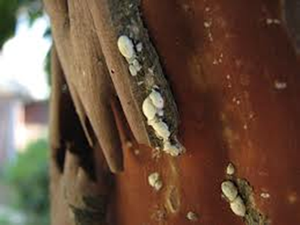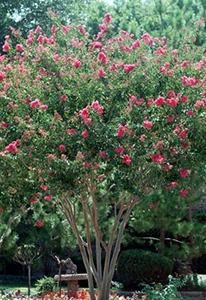With their ability to tolerant extreme heat, moderate pest problems, tolerate a variety of soil types, and continue blooming for long periods, crape myrtles remain very popular in Southern landscapes. However in addition to their susceptibility to pest such as aphids, whiteflies, and cercospora leaf spot, it appears that there is another pest that has many horticulturist and entomologist concerned. Initial sightings of the Crape Myrtle Bark Scale was in north Dallas, Texas in 2004. The presence of this pest was confirmed in Shreveport, Louisiana, in 2012 and in Houma, Louisiana, in 2013; it has also been reported in Caddo and Bossier parishes and is suspected in Webster and Rapides, and it seems to be spreading fast. LSU AgCenter Horticulturist Allen Owings, PhD, residing at the Hammond Research Station, indicated to me that no positive identification has been confirmed in Lafayette, but it is suspected that it may already be in this parish. It shouldn’t be hard to recognize since it is the only known bark scale to occurs on crape myrtles.
At this time there are no studies to determine if some crape myrtle cultivars are more likely to be infested than others. One of the symptoms of crape myrtle bark scale is that a heavy infestation produces heavy sooty mold on the bark. Most of us are familiar with sooty mold as it occurs on citrus, gardenia, hibiscus and also on the leaves of crape myrtles. As you may recall, we’ve discussed it several times in past horticulture articles, sooty mold is a result of sucking pest such as scale, aphids, and white flies. So if we see crape myrtle showing signs of heavy sooty mold on the bark of crape myrtles, it may be this pest (crape myrtle bark scale)!!! Visually the adult female scale appears as a white or gray encrustation on small twigs and large trunks, very often occurring near wounds, or in branch crotches on older wood.
At this point control is based on limited experience with this pest and it appears that control may be difficult. One recommendations is to first wash/scrub reachable infested branches with water and liquid dishing detergent, which will remove adult females and eggs and sooty mold, making insecticide control more effective. Horticultural oil seems to be ineffective. Dormant oil applied in the winter months may be beneficial but complete coverage of the plant is essential. Only systemic insecticide is showing to be effective when applied as a soil drench over the root zone of infested crape myrtles in May and July.
Imidacloprid is one of systemic insecticides that is recommended. Imidacloprid is the active ingredient in Bayer Advanced Garden Tree & Shrub. Additionally Greenlight Tree & Shrub with Safari is also recommended.
I’ve already been contacted by one of our local retail nursery/garden centers requesting information from the LSU AgCenter regarding this pest. As this situation unfolds I will keep you updated as information becomes available. As Master Gardeners, you can assist the LSU AgCenter by paying close attention to pests on crape myrtles, and if you suspect an infestation of crape myrtle bark scale, please contact me so we can get a positive identification. We don’t know to what extent this pest will impact crape myrtles or how fast it will spread once it is confirmed in an area; however, I feel confident that entomologist and horticulturists in Louisiana and surrounding States are already working on result demonstrations to determine an effective means of control.
For identification purposes, pictures of the crape myrtle bark scale can be found on the University of Arkansas’s website, or if you google crape myrtle bark scale, then click on images. Several pictures of the pest will pop up for viewing.
As I come to a conclusion, we are reminded of the unpredictability of mother nature, especially as it relates to the coldest winter we’ve had in several years. Just another reminder that even though we plant tender plants in our landscapes we must always remember that sooner or later we’re going to have to give them some protection. The alternative is having them severely injured or killed by freezing temperatures. Let me remind you that several factors determine the severity of damage. The degree of cold hardiness (which depends on the plants) certainly comes to play, but also the age of the plants, health of the plant, location of the plants, and the duration of freezing temperatures.
I communicated with Dan Gill and Allen Owings and both indicated that if we did get down to 19 degrees or below in the Lafayette area, as has been projected), we can expect damage not only to many of the tropical plants , but also on palms with the most vulnerable being queen palms. At that cold temperature, citrus plants can also be expected to have some damage — but to what extent? That will not be known for several months. As Dan Gill indicated, we must not be in any hurry to prune woody type plants or palms but rather wait until April, May or even into June or July. By that time mother nature will show us the extent of the damage and after that time, we will know how much to prune or if certain plants have survived at all.




 RSS Feed
RSS Feed